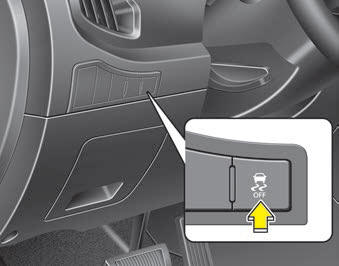 Kia Sportage: Electronic stability control (ESC)
Kia Sportage: Electronic stability control (ESC)

The Electronic Stability control (ESC) system is designed to stabilize the vehicle during cornering maneuvers. ESC checks where you are steering and where the vehicle is actually going. ESC applies the brakes on individual wheels and intervenes with the engine management system to stabilize the vehicle.
Electronic stability control (ESC) will not prevent accidents. Excessive speed in turns, abrupt maneuvers and hydroplaning on wet surfaces can still result in serious accidents. Only a safe and attentive driver can prevent accidents by avoiding maneuvers that cause the vehicle to lose traction. Even with ESC installed, always follow all the normal precautions for driving - including driving at safe speeds for the conditions.
The Electronic Stability Control (ESC) system is an electronic system designed to help the driver maintain vehicle control under adverse conditions. It is not a substitute for safe driving practices. Factors including speed, road conditions and driver steering input can all affect whether ESC will be effective in preventing a loss of control. It is still your responsibility to drive and corner at reasonable speeds and to leave a sufficient margin of safety.
When you apply your brakes under conditions which may lock the wheels, you may hear a ŌĆ£tik-tikŌĆÖŌĆÖ sound from the brakes, or feel a corresponding sensation in the brake pedal. This is normal and it means your ESC is active.
✽ NOTICE
A click sound may be heard in the engine compartment when the vehicle begins to move after the engine is started. These conditions are normal and indicate that the Electronic Stability Control System is functioning properly.
 Anti-lock brake system (ABS)
Anti-lock brake system (ABS)
ABS (or ESC) will not prevent accidents due to improper or dangerous driving
maneuvers. Even though vehicle control is improved during emergency braking, always
maintain a safe distance between yo ...
 ESC operation
ESC operation
ESC ON condition
When the ignition is turned ON, ESC and ESC OFF indicator lights illuminate
for approximately 3 seconds, then ESC is turned on.
Press the ESC OFF button for at least half a s ...
Other Information:
Window opening and closing
Type A
The driverŌĆÖs door has a master power window switch that controls all the windows
in the vehicle.
To open or close a window, press down or pull up the front portion of the corresponding ...
RCV Control Solenoid Valve: Description and Operation
Description
RCV (Recirculation Valve) Control Solenoid Valve is installed
on the intercooler inlet pipe and operates the RCV actuator which
controls the by-pass passage of the turbocharger comp ...
Categories
- Home
- Kia Sportage QL (2015-2019) Owners Manual
- Kia Sportage QL (2015-2019) Service Manual
- Kia Sportage SL 2010-2016 Owners Manual
- Kia Sportage SL 2010-2016 Service Manual
